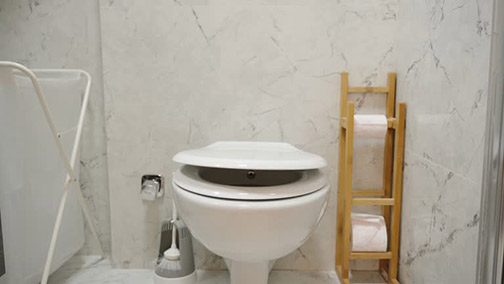
Is your toilet making a loud hissing noise, like the tank is refilling every 5 minutes or so?
Maybe the sound of the running water in your toilet is keeping you up at night, or you are worried about getting a hefty water bill in the coming weeks.
We are here to help. This post explains why your toilet is making annoying noises and what you can do to fix the problem.
But first, use this temporary fix noted by Keyrenter Jacksonville if…
Regardless of the cause of the issues in your toilet, the water should stop running when you turn off the angle stop. If, for any reason, you are unable to fix the problem right away, you can close the toilet’s angle stop and reopen it whenever you need to flush your toilet.
An old and rigid flapper
The first thing is to check if the toilet is leaking. If, as we suspect, the problem is due to a malfunctioning flapper, you will see ripples across the face of the water inside the toilet bowl. This is because of the water leaking from the tank into the bowl.
Next, reach into the tank and push down on the flapper. The flapper is the rubber seal that sits directly on top of the valve opening at the bottom of the tank. Its job is to seal the valve and prevent water from running into the bowl when the toilet is not flushing.
To fit snugly over the valve opening and seal it, the flapper should be soft. An old flapper that has become rigid will not create a tight seal. This may be why water is leaking into the toilet bowl, causing the toilet tank to constantly refill.
To check if this is the problem, press down on the flapper to see if water stops leaking into your toilet bowl. If it does, it means you have a malfunctioning flapper. Replacing the flapper will solve your problems. When purchasing a new flapper, it is a good idea to take your old one along to ensure you buy one that matches your toilet.
Cracked flush valve
Sometimes, the flapper is not the problem. Even if the flapper is in good condition and creating a tight seal above the flush valve, your toilet will run if the flush valve itself is damaged. If the edge of the flush valve is chipped, you will have a nonstop flow of water into the tank.
Replacing a flush valve is easy; however, it is a fairly involved process that requires you to take down the toilet tank. You may want to have a professional plumber undertake this part of the problem. A good plumber should be able to replace your flush valve within an hour.
Broken ball valve
In older toilets, the tank has a ballcock or ball float valve. As the name implies, this is a prominent ball found inside the toilet tank. The ball valve controls the mechanism that allows the tank to fill after it has been emptied during flushing.
When the tank is empty, the ball drops to the bottom of the tank, opening the water inlet valve to let water flow into the tank. As water fills the tank, the ball rises slowly with the water level, gradually closing the valve until it is completely shut. This stops the flow of water.
However, if the ball valve is broken, it will not work. Instead of rising with the water level inside the tank, it will remain underwater. Because the water inlet valve is not closed, water will flow into the tank nonstop. This excess water will escape from the tank via the overflow pipe.
The sound of water flowing into the overflow pipe is what causes the strange noise you hear from your toilet. To fix this problem, simply replace the ball valve.
Faulty fill valve
Modern toilets have a fill valve assembly in place of a ballcock valve. Just like a ball valve, the fill valve can malfunction, causing unchecked water flow into the toilet tank. This problem is often due to a worn seal or debris inside the fill valve assembly.
To fix this, disconnect the screw that holds the fill valve to the float valve. Open the fill valve by gently lifting the top and turning it counterclockwise. Check inside the fill valve cap for a diaphragm valve. If there is debris inside it, wash it thoroughly with soap and then rinse it.
If there is debris inside the fill valve, open the angle stop to flush out the dirt with water. If this solution doesn’t work, the only option is to replace the entire fill valve assembly. If this is what you should do, please contact a local plumber.

